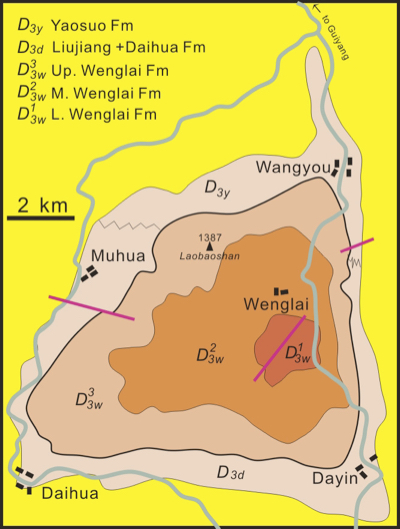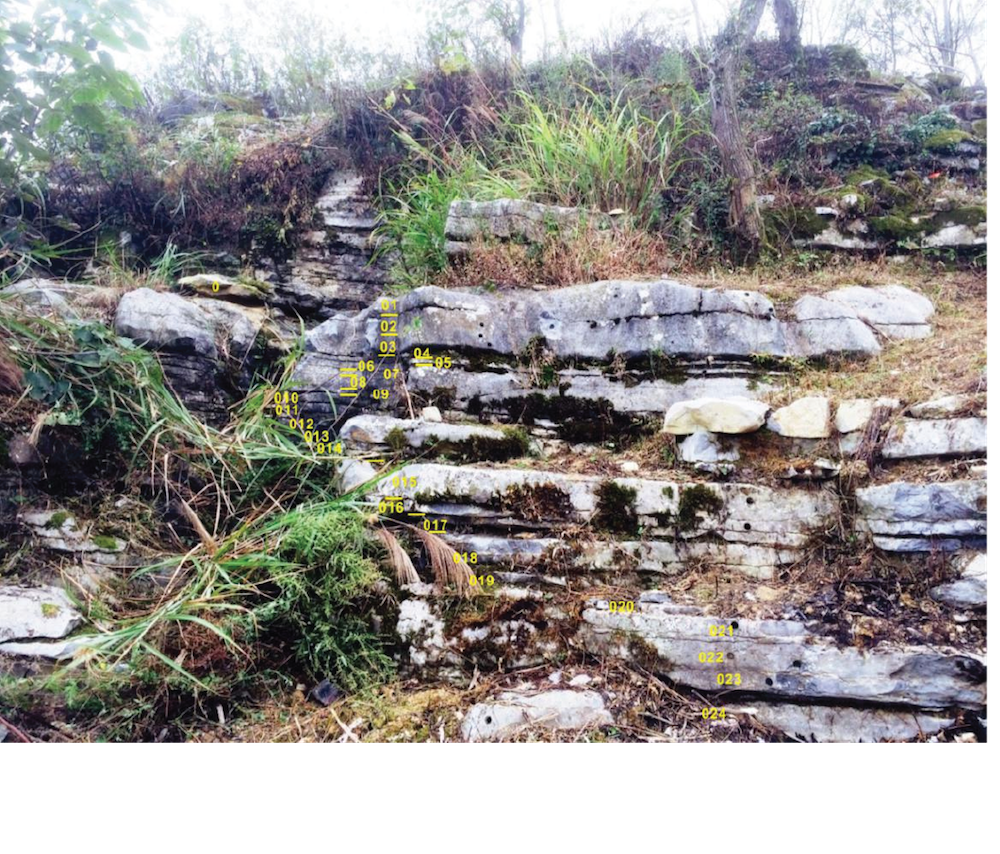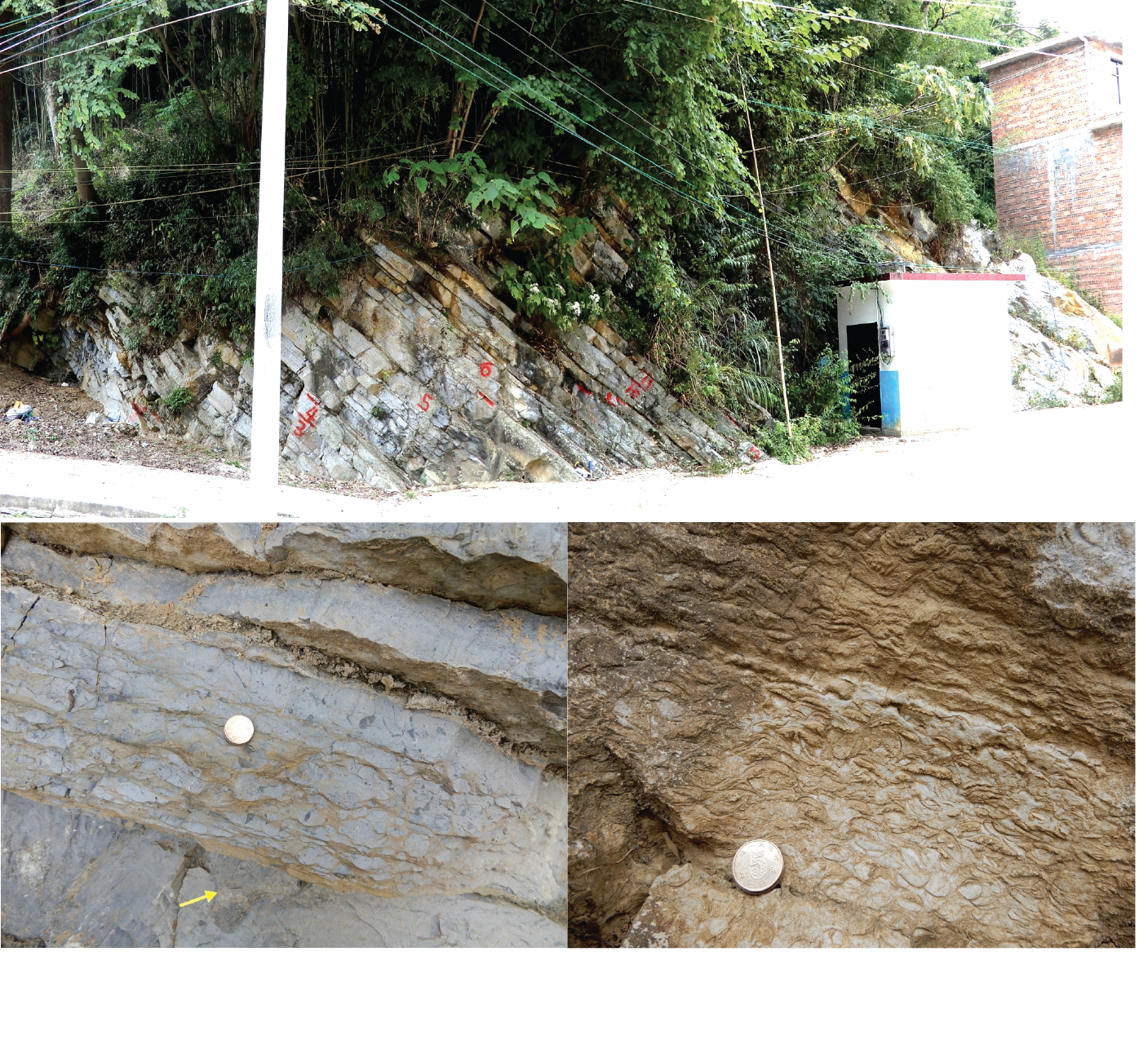Daihua Fm
Type Locality and Naming
The type section is located at the Daihua Town of Changshun County, Guizhou Province (Muhua GPS: 106°24′21.9′′E, 25°48′16.71′′N, Figure). A good reference section with numerous brachiopod beds is developed in the Changtang village near Xiada of Liuzhai, Nandan County of Guangxi (GPS: 107°25’11.19’’E, 25°22’23.93’’N). There is a dome structure in the area between Wangyou, Dayin, Daihua and Muhua villages with the core consisting of Givetian Wenglai Fm, around which the upper Devonian to Carboniferous strata are developed forming flanks (Figure). The formation was named by the Fifth Prospecting Team of the Ministry of Geology and was quoted by Sun and Shen in 1965 as a member of Upper Devonian. Then, it was promoted a formation level in 1966 by the Regional Geological Survey Team of Guizhou.
[Figure Simplified geological map showing the type locations of Daihua Fm and Wenglai Fm in Daihua and Muhua (D3d).]
Lithology and Thickness
Limestone. The formation can be subdivided into three parts. The lower part, about 75 m thick, consists of light gray, grayish medium-bedded micritic limestones intercalated with thick bedded breccia limestones and thin siliceous rocks and shales. The middle part, about 40 m thick, is composed of medium-bedded micritic limestones with gutter casts and thin bedded light gray, gray stripe limestones, which are interbedded by fine irregular or wave muddy bands. Various types of tempestites can be recognized. A few nodular limestones are occasionally observed. The upper part, 35 m thick, is marked by the homogenous light grayish medium to thin well-bedded micritic limestones. Stylolites are common.
[Figure Photograph showing the outcrops of upper part of Daihua Formation in Daposhang Hill of Muhua area.]
[Figure Outcrop photographs showing the section of middle part of Daihua Formation in the Changtang (upper),with the stripe limestone (lower left) and the shelly bed (lower right). Note the erosional surface with mud-filling gutter cast structure (yellow arrow), they all represent tempestites. Diameter of coin 1.9 cm.]
Relationships and Distribution
Lower contact
The basal contact with the underlying Liujiang Fm is sharp. It has a distinct lithological change from siliceous rocks to limestone of overlying Daihua Fm.
Upper contact
It is disconformably overlain by black shale of Gedongguan Bed Fm (Member), Wangyou Fm with sharp contact and abrupt change both in lithology and fossils contents.
Regional extent
The formation is distributed in the Daihua-Daying-Muhua area, Dayao of Puding in Guizhou, Tiandeng, Duli of Liuzhai and Changtang in Guangxi. Eastward to Nandan area of Guangxi and southward to Luodian and Ziyun it can be correlated to Wuzhishan Fm which is characterized by more nodular limestone and absence of shelly beds.
GeoJSON
Fossils
Abundant ammonoids, conodonts, trilobites, etc. are found in the upper part, among them two ammonoid zones: Clymenia laevigata Zone below and Parawocklumeria paradoxa Zone above were recognized. The trilobites are rich in the topmost beds including Mirabole muhuaensis, Dinopsis sp., Typhloproetus sp., Phacops (Omegops) accipitrinus, etc. A large number of conodonts are well distributed include almost all Famennian zones from Palmatolepis triangularis to Siphonodella praesulcata. Those in the uppermost part was studied in details, including expansa Zone and praesulcata Zone. About five shell beds consisting of a main monospecific brachiopod Dzieduszyckia bashkirica are reported from Daihua, Duli and Changtang (GPS:107°25’11.19’’E, 25°22’23.93’’N) occurring at Palmatolepis Marginifera Zones.
Age
Depositional setting
The lithology and fossil features indicate a platform margin to upper slope environment, commonly seen in the facies change area between open platform and basin setting.
Additional Information
Previous works have proposed that due to administrative reasons, different name was applied to same stratigraphic units in different provinces, such as the Daihua Fm was used in Guizhou while the Wuzhishan Fm in Guangxi, although they have similar lithology. Therefore, the Daihua Fm has been abandoned in Chinese literatures for a long. The recent investigation shows that the two formations are quite different both in lithology and depositional environment. Lithologically, the Daihua Fm is characterized by the thin limestone intercalated with irregular and wave muddy bands, which display strip appearance. The nodular limestone, which is main feature in Wuzhishan Fm, is very rare or absence in Daihua Fm. In addition, the Daihua Fm contains a number of shelly bed interbeds consisting of cosmopolitan brachiopods. Therefore, the name of Daihua Fm should be kept representing a peculiar lithofacies.


